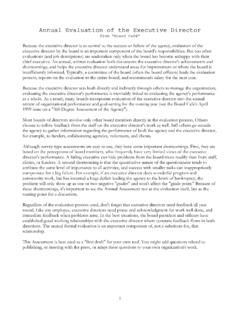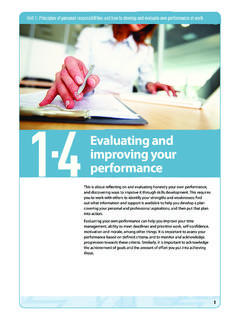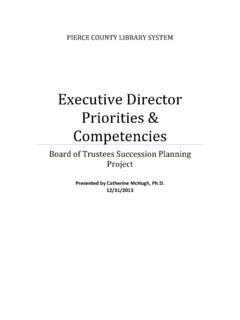Transcription of A Guide for Evaluating the Requirements of …
1 Developed by:The Clean Fuels Development CoalitionandThe Nebraska Ethanol BoardIn Cooperation withThe Department of AgricultureSummer 2006A Guide for Evaluating the Requirements of Ethanol PlantsInformation contained in this publication was initially developed under an agreement between the CleanFuels Foundation and the Clean Fuels Development Coalition in cooperation with the Nebraska EthanolBoard. This ethanol plant Guide was developed to assist communities, cooperatives and other agriculturalorganizations in making an initial determination regarding the economic feasibility of developing an ethanolproject. Information contained in this document is considered to have applicability to biofuel processing ventures aside from ethanol projects. Readers of this document should consider the information to be forgeneral application only.
2 Communities with an interest in Evaluating prospective ethanol projects in moredetail may wish to contact local and state economic development agencies in their respective of this document may also want to review information contained in the Ethanol Fact Book. Copies of this publication areavailable via the Nebraska Ethanol Board web site cooperation with the Clean Fuels Development the Clean Fuels Foundation, sponsors of Ethanol Across America Additional information about the economic impacts and energy balance of ethanol production is also available photo of ethanol plant courtesy of Readers:During the past decade, interest in the production of biofuels from renewable resources has continued to growthroughout the United States. Major grain producing states have placed special emphasis on the production ofethanol.
3 The production and use of ethanol generates a variety of essential economic activity at the local, state and national level. (Readers wishing to learn more about specific economic benefits associated with the production of ethanol may wish to review the CFDC Issue Brief series available at ) As concerns about the economic downturn in the agricultural sector and rural communities continue to mount,many groups and individuals have been motivated to consider the potential for producing ethanol. Across thecountry, farmer cooperatives, rural development coalitions, bio-energy advocates and others have gathered toexplore the process and prospects for developing ethanol production facilities. In many cases these efforts haveresulted in the successful development of ethanol plants. The current demand for ethanol and the projected increase in the use of these fuels under a national renewablefuels standard continues to stimulate interest in the prospects for the development of new ethanol plants.
4 This publication is designed to assist interested parties during the initial stages of Evaluating the potential for development of a processing facility. During this process, interested parties can consider the Requirements andpotential impact of an ethanol production facility in a community or region of the state. With this information,the parties can make a more informed decision about the viability of a proposed project and the level of commitment and cost required to interested in development of ethanol processing plants are often attracted by the variety of economic benefits generated by the plants. The value-added aspects of producing a high value product from lower cost rawmaterials has considerable appeal in agricultural states and areas where reliable supplies of biomass feedstocks example, high protein co-products made in the fuel ethanol production process, such as distillers dried grainsand gluten feeds, have gained the full acceptance of feedlot operators and dairymen as premium feeds for their cattle.
5 Used in wet form, these protein feed supplements induce significant economic benefits for the livestock and dairy industries while reducing the input of energy at ethanol plants. These high value co-products also represent billions of dollars in value-added exports. In many states where virtually all liquid transportation fuels must be imported from sources outside the region, the use of ethanol can also help retain energy dollars in the state s economy when such fuels are produced a broader scale, the use of ethanol nationally will also help offset our dependence on imported oil. Under nocircumstance should dependence on imported oil at the level we are now experiencing in the be production of renewable biofuels from a host of feedstock materials can play an increasingly importantrole in meeting our transportation fuel needs while creating opportunities for rural economic Guide for Evaluating the Requirements of Ethanol Plants(continued on page 2)Major advances in technology to convert cellulosic biomass into fuel ethanol have set the stage for a significantexpansion of the ethanol industry during the next decade.
6 Advances in genetics, farming practices, feed grain andoil bearing crop production will increase the efficiency of producing biofuels from conventional and new energycrops. More importantly, the use of cellulosic biomass ( , agricultural residues, wood wastes, yard and gardentrimmings and the biomass fraction of municipal waste) essentially eliminates the upper boundaries to the production of increasing demand for ethanol is evident today and the prospects for additional use of this renewable fuel lookpromising. Many states are ideally suited for the development of ethanol production facilities. Reliable supplies ofraw materials, mature transportation systems, competitive energy costs and a strategic position relative to nationalmarkets provide excellent opportunities for development of ethanol plants in dozens of states. The Clean Fuels Development Coalition and the Nebraska Ethanol Board are working with a variety of organizationsand agencies throughout the United States to support development of ethanol plants.
7 As communities, cooperatives,rural development organizations and others consider the prospects for ethanol development, a variety of resourcesare available to support this process. This publication was designed to provide initial guidance for Evaluating thepotential for local production facilities. Other resources are noted in the this document provides useful information about various Requirements for siting ethanol plants, readersshould not rely on the information contained herein to provide advice on related investments. This document is intended for use as an ethanol plant assessment Guide produced for use by organizations with an interest in ethanol plant development. However, the process discussed is generally relevant for other biofuelsprojects as well. Many communities will find the site location criteria to be most useful in Evaluating potentialsites for proposed ethanol plants.
8 While the Requirements of each proposed facility will vary, the infrastructurerequirements outlined in this document should provide useful information for local economic development organizations and community leaders. This publication is designed only to provide guidance during the initialstages of project evaluation and site assessment. We appreciate the support of the Department of Agriculture on this project. We hope that readers find this publication useful in the process of considering ethanol production opportunities across the country. Sincerely,Douglas A. Durante, Executive DirectorTodd C. Sneller, AdministratorClean Fuels Development CoalitionNebraska Ethanol Board2 Introduction from Department of Agriculture:Undersecretary Tom Dorr ..5 Initial ConsiderationsBeginning the Process ..7 Organization ..8 Project Coordination.
9 8 Basic Considerations in the Pre-Feasibility EvaluationAssessment Considerations ..9 Resources ..9 Project Coordination Options ..9 Pre-Feasibility ConclusionsProject Variables ..10 Evaluating Options ..10 Initial Delineation ..11 Primary Criteria ..11 Plant Site Selection Factors ..12 Feedstock ..12 Energy Requirements ..13 Transportation ..14 Water Requirements ..14 Site Size and Location ..15 Community Support ..16 Community Citizenship and Community Relations ..17 Corporate Communication ..17 Facilitating Buy-in via Effective Communication ..18 Other Factors Related to Site : Ethanol ..18 Markets: Distillers : Carbon Dioxide ..20 Regulatory PermitsEthanol Plant Emissions ..22 Air Quality Permits ..22 Construction ..23 State Construction Permits ..23 Federal Construction Information ..25 Emissions Information.
10 253A Guide for Evaluating the Requirements of Ethanol PlantsTable of ContentsIntroduction -Pre-Feasibility Evaluation -The Feasibility Study -4 Table of Contents (continued)Control Equipment and , Recordkeeping and ..28 Permit Application Content ..30 Other Permitting and Compliance Tips ..30 Value of Overview of Incentive Programs ..31 Federal Incentive Tax Tax Credit for Alcohol Production Tax Credit ..32 Income Tax Credit for Small Producers ..32 Loans and Loan Guarantee Programs ..32 Grant Programs ..32 Cooperative Financing ..32 Feedstock Incentives ..33 Other Federal Incentives ..33 State & Local Incentive Requirements ..34 Fuel Tax Incentives ..34 Targeted State Incentives ..34 Ethanol Production Payments and Credits ..34 Loan and Loan Guarantee Tax Credits ..35 Other Tax Credit Incentives ..35 Equity Investment Programs.







